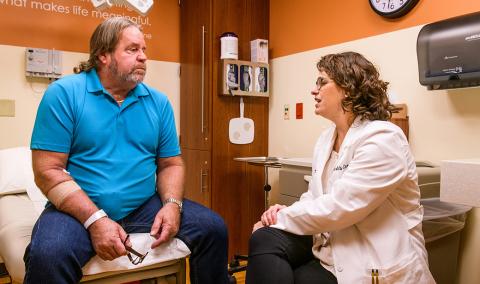Finding out you have bladder cancer can be overwhelming for you and your loved ones.
Cancer of the bladder is the second most common urologic cancer and is one of the ten most common cancers in the United States. It is also a diverse disease, with some patients only having a non-invasive, low-grade version and others having a more advanced version of bladder cancer. Those with non-invasive, low-grade bladder cancer have a low metastatic rate, meaning a low likelihood of the cancer spreading to other parts of the body. However, these patients have a high rate of recurrence after treatment.
At MU Health Care, we work closely with other specialty groups — such as medical oncology and radiation oncology — to develop a comprehensive, personalized treatment plan for each of our patients.
Symptoms of bladder cancer
Most of the time, bladder cancer is diagnosed after finding blood in the urine – either visually detectable or detected under microscopic analysis. Other common symptoms that may indicate bladder cancer include increasing frequency of urination and urgency to urinate.
How bladder cancer is diagnosed
If your doctor suspects you may have bladder cancer, he or she will likely recommend the following options to aid in diagnosis:
- Biopsy. During cystoscopy, your doctor may pass a special tool through the scope and into your bladder to collect a biopsy (sample of cells) for further analysis. This procedure is also known as a transurethral resection bladder tumor (TURBT) and is generally performed under general anesthesia and without any incisions.
- Complete physical exam. Your doctor performs a physical examination and gathers history from you to better understand your signs and symptoms related to bladder cancer.
- Computed tomography (CT) scan. A CT scan allows your doctor to obtain a detailed picture of your urinary tract and surrounding tissue.
- Diagnostic cystoscopy. Usually done in the office with local anesthesia, this technology allows our specialists direct visualization of the lining of the bladder. We use advanced digital, flexible cystoscopes that allow you to observe the examination along with your doctor.
- Urine cytology. Your doctor analyzes a sample of your urine under a microscope to check for cancer cells.
- X-ray. An X-ray allows your doctor to closely examine the structures of your urinary tract. We have the ability to use fluorescent dyes in the bladder that helps us better identify the tumors.
Treatments for bladder cancer
MU Health Care offers a wide spectrum of treatment for bladder cancer. The treatment options available to each person depend on the type and progression of bladder cancer, as well as the person’s overall health.
The treatments we offer include:
- Chemotherapy. Completed in coordination with a medical oncologist, the administration of intravenous chemotherapy (drugs to combat the cancerous cells) is an alternative treatment that may be appropriate for some patients. In patients with advanced muscle invasive bladder cancer, chemotherapy may be administered prior to a radical cystectomy.
- Radiation. In this therapy, a laser sends high doses of radiation directly to the cancer cells. The radiation helps to slow the growth of cancerous cells by making small breaks in the DNA inside the cells.
- Radical cystectomy. A treatment for those with muscle invasion bladder cancer, this is an aggressive treatment that involves complete removal of the bladder and creation of a replacement bladder. This can be completed via ileal conduit urinary diversion (using a part of the small intestine to drain urine) or with an orthotopic neobladder (a piece of intestine is configured into an artificial bladder).
- Transurethral resection of bladder tumor (TURBT). TURBT can be used to remove bladder cancers that are confined to the inner layers of the bladder. In this procedure, your surgeon burns away cancer cells with an electric current or high-energy laser.
We also offer participation in research trials in combination with medical oncologists and radiation oncologists, for some patients. Talk with your MU Health Care urologist for more information.
Improving patient outcomes with the Tiger protocol
The bladder cancer treatment team are leaders in the TIGER Protocol, which is a comprehensive set of guidelines that has led to improved patient outcomes following major surgery, including cystectomy (removal of the bladder).
For this protocol — which addresses preoperative, intraoperative and postoperative care — we collaborate with the following specialists:
- Anesthesiologists
- Dietitian
- Nurse navigators
- Physical therapists
- Surgeons



























